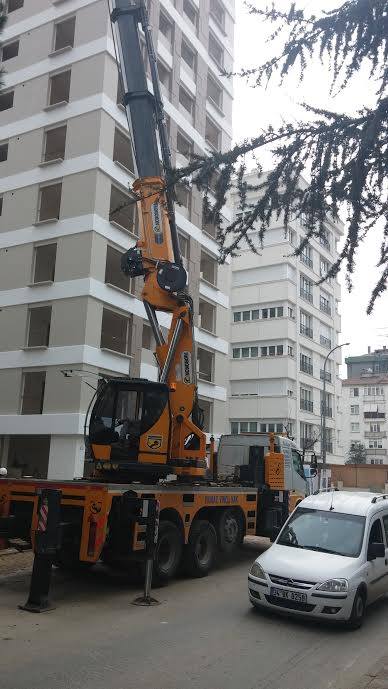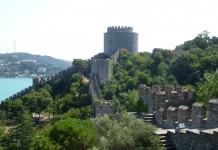Bağdat Caddesi is a long, wide shopping avenue on the Asian side of the city, Istanbul’s equivalent of 5th Avenue or Rodeo Drive.
Nearby are the neighborhoods of Suadiye, and Bostancı, as well as Göztepe Park. Here, on any given day, you see housewives of the country’s richest men, sitting in cafes, sipping lattes with Louis Vuitton bags in hand.
Within five minutes’ walking distance you’ve got a winding coastal road looking out at the Sea of Marmara, which throws Mediterranean light and breezes across the road into the cream-colored apartment buildings.
What price, luxury? In this part of town, even a small flat will cost you upwards of $300,000 US.
But the cool elan and quiet atmosphere of these neighborhoods have largely vanished these days. Usually the roads are choked with yellow tractors and cranes, and the sound of jackhammers and drillers beat a steady, restless tattoo.
That, my friend, is the sound of arguably the biggest business in Turkey. It’s become a downright mania.
Just to give an example: On the street near my school in Suadiye, no less than two thirds of the apartment buildings have been demolished and rebuilt in the past two years, and in the surrounding streets I could probably count another 40 or 50 — in various stages of planning, building and completion.
“This city has got construction fever,” remarks Ahlam, a Turkish-American teacher whose family lives in the neighborhood. This was some time ago, when she and I were on our way to an in-company lesson. As usual, the roads were blocked up, while we waited for two cement trucks to move out of the way.

****
There’s a reason for this fever, and it’s not just money (although if you ask most Turks, they’ll say that’s the sole reason; the Turkish government relies heavily on the industry for taxes, they argue)
Sure, construction is a big industry here, but the driving force, or rationale, goes deeper: The Big One.
Istanbul sits on the north Anatolian faultline, one of the most seismically active in the world. Memories of the 1999 earthquake, which killed nearly 20,000 people, and left many more without homes, still haunt this city.
One of the big reasons for the devastation in 1999 was the reportedly poor condition of many of the city’s apartments — a reflection of somewhat lax building codes. It doesn’t help that with some 15 million residents, Istanbul is a crowded place, with many old buildings literally built on top of one another.
Nowadays, the city seems to be — outwardly at least — preparing for the next Big One — which geologists say could hit Istanbul at any time.
I’m no geologist, but from what I’ve been told, the reason why so many of the apartment buildings in Suadiye, Bostancı and the other adjoining neighborhoods are getting so much attention lies beneath the buildings themselves. Where my wife and I live, in Koşuyolu, we’re lucky that our apartment was built on bedrock, a solid surface.
But in this part of town, off Bağdat Caddesi, much of the ground is soft, almost land-fill.
So if that’s the case, what good will the new buildings do? Good question.
From what I can see, with the naked eye, the new apartments look no safer than the old ones did. They’re just newer and shinier — and more expensive.
Of course, the construction companies would no doubt disagree. They’ll have you look closely at the quality of the work, the smooth surfaces. Indeed, many of them do look handsome, with crown molding and dark wood paneling.
But as a former, longtime California resident, I’m familiar enough with earthquakes to know that unless the entire building is wooden (it’s more flexible than stone or brick), then you’ve got to have some kind of seismic insulators built at the base – you know, like they have at the new terminal at Sabhia Gokcen Airport. The terminal rests on these flexible insulators, which are supposed to absorb most of the shocks.
Judging from most of what you can see in Suadiye and Bostanci, none of these new apartments seem to have anything resembling seismic insulators. But what do I know? Maybe they’re buried deep down below.
Anyway, the point of this story was just to show you the extent of the construction craze in this side of the city — it’s the same everywhere, sure — and to stop and wonder, why? Could it really all be an inflated industry, buoyed by a government relying on the influx of tax dollars?
Or could the new buildings really be safer if, and when, the next Big One comes?
Personally, I’m not sold on any of them. We’ll stick with our place in Koşuyolu, although, as my lovely wife so often reminds me, we’re too poor to afford to live near Bağdat Caddesi anyway.
Ah, let them have their expensive flats! We’ll stay in our comfortable poverty, Suadiye and Bostancı be damned! For $300,000, all I’ll say is that if the next Big One does indeed come, they’d better hope the construction was done right. After all, that’s a lot of money. And God knows, the rest of us have put up with the concrete trucks, cranes, jackhammers and traffic jams that produced them long enough.
Of course, this story was just a snapshot of one particular area of the city. What about the rest of this sprawling city? What about the other buildings besides apartments – schools, municipal centers, shopping malls, leveled car parks? Something about the sheer number of them fills me with something less than total confidence. But that’s a fact of life living in Istanbul. Doesn’t matter how much you build, or how much you spend. Nothing can ever truly prepare us for the Big One. They’re still trying to figure that one out in California, too.
James Tressler is a writer and teacher. His books, including the recently published, “City Scherzos: New Stories from Istanbul,” can be found at Lulu.com.











